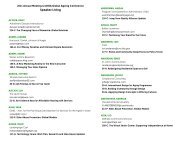The Anatomy of Change The Anatomy of Change - LeadingAge
The Anatomy of Change The Anatomy of Change - LeadingAge
The Anatomy of Change The Anatomy of Change - LeadingAge
Create successful ePaper yourself
Turn your PDF publications into a flip-book with our unique Google optimized e-Paper software.
Responding To <strong>Change</strong>, Making <strong>Change</strong><br />
<strong>The</strong> world has always been about<br />
change, but it seems to be upon us<br />
with greater ferocity these days. Old certainties,<br />
social and political relationships<br />
and long-standing balances <strong>of</strong> power are<br />
shifting both at home and abroad. Anyone<br />
running a provider organization must be<br />
thinking about what will be expected in<br />
years to come, and perhaps ready to cope<br />
with austerity the likes <strong>of</strong> which we have<br />
Gene Mitchell<br />
not seen for decades.<br />
“<strong>The</strong> <strong>Anatomy</strong> <strong>of</strong> <strong>Change</strong>,” this issue’s theme, is one we will<br />
need to cover continually. I’m optimistic enough to see change<br />
as opportunity, and lots <strong>of</strong> <strong>LeadingAge</strong> members are as well.<br />
That’s why they are rethinking business models, building partnerships<br />
and finding new people to serve.<br />
In “<strong>The</strong> <strong>Anatomy</strong> <strong>of</strong> <strong>Change</strong>” (p. 6), you’ll see how a few<br />
provider organizations have changed their business models,<br />
partly out <strong>of</strong> necessity and partly because their visions compel<br />
them to advance their missions.<br />
<strong>The</strong> seniors we traditionally serve are changing and providers<br />
adapt. Some take it a step further and take on responsibility<br />
to serve new and/or underserved populations. Learn how in<br />
“Reaching the Underserved” (p. 12). While some providers<br />
reach the underserved by changing their service mix, others do<br />
it by partnering and integrating their own well-earned expertise<br />
with other entities. See “<strong>The</strong> <strong>Anatomy</strong> <strong>of</strong> Partnerships” (p. 16)<br />
vision continued from page 4<br />
him frequently. I reviewed this situation with Whittington. He<br />
asked me one day how I was doing. I replied, “My work has<br />
never been more complicated. I have never felt more responsibility<br />
for the people we serve even when they are served by<br />
organizations we don’t manage. I have never felt more out <strong>of</strong><br />
control <strong>of</strong> what happens. And I have never been more excited<br />
about the potential we have to help people better.”<br />
Whittington responded, “<strong>The</strong> business relationship principle<br />
you are experiencing is this: You and your colleagues have all<br />
chosen to give up a measure <strong>of</strong> control to gain more power for<br />
the people you serve in the marketplace.”<br />
<strong>The</strong> power <strong>of</strong> community may be the only thing that will<br />
improve service delivery to seniors while curbing costs. <strong>The</strong><br />
“trusted guide” is the key role. Who better than you? Guiding<br />
seniors, guiding the development <strong>of</strong> innovative communities:<br />
your leadership challenge.<br />
from the editor<br />
to see how these partnerships arise and are maintained.<br />
An important part <strong>of</strong> health care reform, from the eyes <strong>of</strong><br />
health providers <strong>of</strong> all stripes, is the anticipated growth <strong>of</strong><br />
accountable care organizations (ACOs). While many <strong>of</strong> the<br />
details <strong>of</strong> how ACOs will be structured and operate are still<br />
being worked out, it’s not too early for aging-services providers<br />
to think about how they may fit into that system in years to<br />
come. See “<strong>The</strong> ACOs Are Coming” (p. 20), to learn more.<br />
Our feature on p. 24, “A Switch (Just) in Time,” was a story<br />
we initially planned to integrate into one <strong>of</strong> the features above.<br />
But this tale, <strong>of</strong> two top CCRC executives who switched jobs<br />
as a result <strong>of</strong> careful organizational introspection, was just too<br />
unique.<br />
As we prepare to celebrate our 50th anniversary at this year’s<br />
<strong>LeadingAge</strong> Annual Meeting and IAHSA Global Ageing Conference,<br />
we’re kicking <strong>of</strong>f a series <strong>of</strong> articles on the past and<br />
future <strong>of</strong> the association. See “Celebrating Our 50th” on p. 28.<br />
Providers hoping to improve operations are encouraged to<br />
launch pilot studies when trying out new systems. In “Self-<br />
Scheduling for Nursing Assistants: A Pilot” (p. 36), read about<br />
how one Kentucky organization introduced self-scheduling for<br />
CNAs as a way to reduce turnover and absenteeism.<br />
<strong>LeadingAge</strong> magazine | March/April 2011 5



